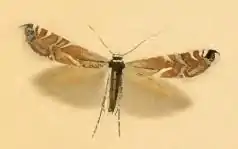Glyphipterix simpliciella
Glyphipterix simpliciella, the cocksfoot moth, is a species of moth of the family Glyphipterigidae.
| Cocksfoot moth | |
|---|---|
 | |
| Glyphipterix simpliciella, upperside | |
 | |
| Lateral view | |
| Scientific classification | |
| Domain: | Eukaryota |
| Kingdom: | Animalia |
| Phylum: | Arthropoda |
| Class: | Insecta |
| Order: | Lepidoptera |
| Family: | Glyphipterigidae |
| Genus: | Glyphipterix |
| Species: | G. simpliciella |
| Binomial name | |
| Glyphipterix simpliciella (Stephens, 1834) | |
| Synonyms[1] | |
|
List
| |
Distribution
This quite common species can be found in the western part of the Palearctic realm and is common in much of Great Britain and Ireland.[2]
Habitat
These small moths mainly inhabit flower meadows, especially with buttercup and there are often many on one flower.[3]
Description
Glyphipterix simpliciella has a wingspan of 6–9 mm.[4] and can reach a length of 3–4 mm. These tiny cryptic moths have dark brown forewings with a slightly metallic sheen. They also show a black apical spot and five white or silvery streaks along their costa, two across the dorsum and one in the posterior corner of the wings. The hindwings are dark grey, with grey cilia. Both sexes are similar.[5]
This species is rather similar to Glyphipterix equitella and Glyphipterix schoenicolella.
Biology
It is a univoltine species. Adults are on wing from May to July. They fly in the sunshine and especially feed on nectar of buttercup (Ranunculus species), Crataegus monogyna, Euphorbia esula, and of various Apiaceae species (especially Leucanthemum vulgare).[6][7]
The larvae feed on the seeds of cocksfoot (Dactylis glomerata), tall fescue (Festuca arundinacea) and Festuca pratensis. They later pupate in the stem.[4][6]
Gallery
 Larva
Larva A head of Dactylis glomerata tenanted by larva
A head of Dactylis glomerata tenanted by larva Glyphipterix simpliciella
Glyphipterix simpliciella
References
- Lepiforum.de
- Fauna europaea
- Nature Spot
- UK Moths
- Taranaki Educational Resource: Research, Analysis and Information Network
- "Lepidoptera of Belgium". Archived from the original on 2017-04-25. Retrieved 2017-04-24.
- Waarneming.nl (in Dutch)